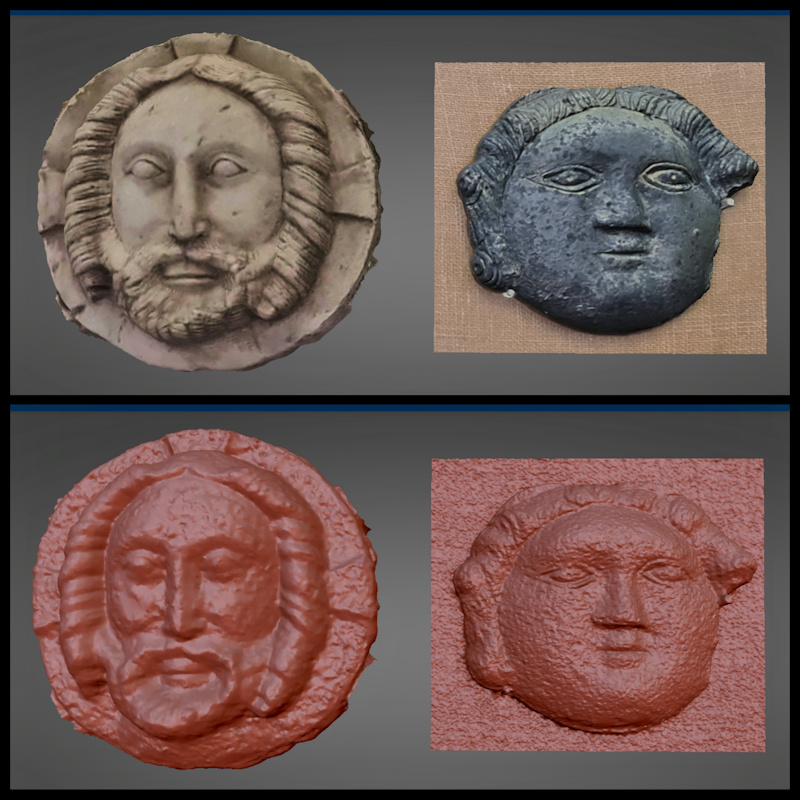Photogrammetry apps sometimes warn us that results may suffer if we use zoomed-in photographs. I’m no expert, and I’m sure there are many other reasons, but I tend to think that’s because indiscriminate use of digital zoom on a smartphone can mean a lot of the image sensor’s pixels are lost, leaving the photogrammetry algorithm little information from which to reconstruct the lens parameters. So I thought it might be fun to try using the 5x zoom setting on a Samsung S20 Ultra smartphone for a couple of test photogrammetry scans: one of a small object nearby and one of a larger one further away.
I chose a zoom setting of 5x on the S20 as it should mean the image sensor data doesn’t need to be cropped too much. That’s because the smartphone has a dedicated telephoto camera with a native zoom level of around 4x (the 10x Samsung claim is actually ‘hybrid optical zoom’ meaning it uses the extra pixels of the 108 megapixel sensor to zoom in more for 12 megapixel photos). Obviously that means my choice isn’t necessarily good for all phones (so you’ll likely need to play around), but it should give a good idea of what’s possible. And to do the photogrammetry tests I chose two difficult to reach objects: a high up ceiling boss and a small bronze face in a display case, as shown below.

The ceiling boss, depicting the face of Jesus Christ, is found high up on the ceiling of the Becket Chapel in St Davids Cathedral, in southwest Wales. The ceiling is from a 14th Century remodelling of the chapel by Bishop Gower, so we can expect the boss to be approaching 700 years old. Given it’s not accessible by visitors I have to estimate the size, but it’s probably around 300mm (1 foot) in diameter. As for the height, it’s quite a high ceiling and I’d estimate it’s at least 4m (13 feet) up. Given that’s quite high even for a 5x zoom, I had to accept there would be quite a lot of surrounding detail in the photos, as you can see below.

The Roman-era bronze face can be found in Newport Museum in south Wales (the plaque states ‘Bronze mount in the shape of a human face. From Caerwent. D.2 876′). It’s quite a small item and, while being behind glass means I couldn’t measure it, I’d estimate it’s less than 100mm (4 inches) across. Assuming that the bronze was from the Roman period of Caerwent, we can probably expect it’s from between the 1st and 4th centuries AD, and so likely over 1600 years old. Fortunately it was possible to hold the phone close to the display case glass, which helped keep it steady while zoomed and improved reflections that could have reduced scan quality.

Before talking about the technical details of the scans, I’m sure you’d really like to see what they look like. So below is a view of both of them, combined together in Blender for comparison, on Sketchfab (click the play button to load the scan and move it around). I hope you’ll agree that, despite them being rather challenging photogrammetry subjects, with limited surface features to detect, the two 3D scans came out quite well. OK, they may not have as much detail as you might hope for high-definition resin 3D printing, but for digital uses, and for general 3D printing, I think they’re pretty good. If you want to you can download them on the Sketchfab page.
In terms of technical details, both scans were made with the excellent Kiri Engine. I set the mesh detail option to high, mostly because I’d be losing a lot of vertices during cropping. For the texture quality I set the ceiling boss to medium (2048×2048 pixels) and the bronze face to high (4096×4096 pixels). In fact I don’t think there was any need for high quality texture images, as there isn’t much texture in the ‘real-world’ objects, but again it helped due to the large number of pixels, especially for the ceiling boss, lost due to the cropped-out surroundings.

Both scans were trimmed, resized and rotated in Meshmixer, and only the bronze face was decimated (in Blender to around 25% of the vertices) as the mesh density was very high. Then the texture images were enhanced a little in Paint Shop Pro as they looked a little washed out. And if you’d like to know a few statistics of the two 3D models you viewed on Sketchfab above, there’s a few in the table below.
| Ceiling boss | Bronze face | |
|---|---|---|
| Photos | 29 | 32 |
| Vertices | 248,592 | 271,911 |
| Triangles | 82,864 | 90,637 |
So, what can I say about the results of this little project? Well, personally I think they show that using smartphone images with optical zooms, in my case around 5x, can be quite suitable for photogrammetry 🙂




